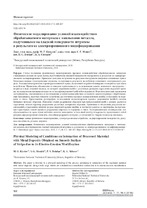| dc.contributor.author | Киселев, М. Г. | ru |
| dc.contributor.author | Монич, С. Г. | ru |
| dc.contributor.author | Богдан, П. С. | ru |
| dc.contributor.author | Сидоров, К. А. | ru |
| dc.coverage.spatial | Минск | ru |
| dc.date.accessioned | 2018-06-01T13:12:22Z | |
| dc.date.available | 2018-06-01T13:12:22Z | |
| dc.date.issued | 2018 | |
| dc.identifier.citation | Физическое моделирование условий взаимодействия обрабатываемого материала с наплывами металла, полученными на гладкой поверхности штрипсы в результате ее электроэрозионного модифицирования = Physical Modeling of Conditions on Interaction of Processed Material with Metal Deposits Obtained on Smooth Surface of Strips due to its Electro-Erosion Modification / М. Г. Киселев [и др.] // Наука и техника. – 2018. – №3. - С. 190-197. | ru |
| dc.identifier.uri | https://rep.bntu.by/handle/data/41719 | |
| dc.description.abstract | Статья посвящена физическому моделированию процесса взаимодействия обрабатываемого материала с наплывами металла по краю лунок, полученными на гладкой поверхности инструмента в результате ее электроэрозионного модифицирования. Приведена методика получения на режущем инструменте (штрипсе) единичных лунок. Описаны основные геометрические элементы, полученные в результате воздействия единичного электрического разряда. Указаны геометрические параметры единичной лунки, полученной на рабочей поверхности штрипсы при таком воздействии. Приведены обоснование и описание примененного в исследованиях макета ленточного инструмента – штрипсы в виде латунной полосы, на которой закреплена шайба с различным радиусом скругления наружной кромки, моделирующая наплывы металла на ее модифицированной рабочей поверхности. Изложена методика проведения экспериментов, заключавшихся в исследовании условий взаимодействия созданного макета штрипсы с обрабатываемым материалом, включая описание устройства для изучения процесса взаимодействия шайбы с образцами из парафина и гипса. Представлены фотографии, позволяющие визуализировать процесс разрушения шайбой (модель наплывов металла) образцов. Показаны стадии разрушения образцов при использовании шайб с разным радиусом скругления, описан характер разрушения различных материалов образцов. Приведены и обсуждены результаты исследований, отражающие влияние формы наружной кромки шайбы, в частности радиуса ее скругления, на протекание характерных стадий процесса разрушения образцов из парафина и гипса. Экспериментально подтверждено, что образовавшиеся по краю лунки наплывы металла, выходящие за исходный контур поверхности, представляют собой режуще-деформирующие элементы, способные разрушать материал, уступающий по твердости металлу наплывов. | ru |
| dc.language.iso | ru | ru |
| dc.publisher | БНТУ | ru |
| dc.subject | Физическое моделирование | ru |
| dc.subject | Электроэрозионная обработка | ru |
| dc.subject | Модифицирование поверхности | ru |
| dc.subject | Режущая способность | ru |
| dc.subject | Резание | ru |
| dc.subject | Штрипса | ru |
| dc.subject | Physical modeling | en |
| dc.subject | Electro-erosion treatment | en |
| dc.subject | Surface modification | en |
| dc.subject | Cutting ability | en |
| dc.subject | Cutting | en |
| dc.subject | Strip | en |
| dc.title | Физическое моделирование условий взаимодействия обрабатываемого материала с наплывами металла, полученными на гладкой поверхности штрипсы в результате ее электроэрозионного модифицирования | ru |
| dc.title.alternative | Physical Modeling of Conditions on Interaction of Processed Material with Metal Deposits Obtained on Smooth Surface of Strips due to its Electro-Erosion Modification | en |
| dc.type | Article | ru |
| dc.identifier.doi | 10.21122/2227-1031-2018-17-3-190-197 | |
| local.description.annotation | The paper is devoted to a physical modeling of the process pertaining to interaction of the machined material with metal deposits along a hole edge which are obtained on a smooth tool surface due to its electro-erosion modification. A technique for obtaining single holes on a cutting tool (strip) is given in the paper. The paper describes main geometric elements which have obtained due to the action of a single electric discharge. Geometric parameters of a single hole initiated on a working strip surface in the course of this effect have been given in the paper. The paper provides a justification and description of a tape tool prototype used in the investigations - brass band strips, on which a washer with different rounding radius of an outer edge is fixed. The prototype makes it possible to simulate metal deposits on the modified working surface of the strips. The paper presents methodology for carrying out experiments on investigations for interaction of the created strip prototype with a processed material, including a description of a device for studying the process of washer interaction with the samples from paraffin and gypsum. Photographs are given that allow to visualize a destruction process of samples which is caused by a washer (model of metal deposits). The paper shows stages of sample fracture when using washers with different rounding radius and describes nature of the destruction for various sample materials. The results of the conducted studies reflecting an influence of the shape of an outer washer edge, in particular a radius of its rounding, on the course of characteristic stages in the process of destruction of samples from paraffin and gypsum are presented and discussed in the paper. It has been experimentally confirmed that metal deposits which are formed at the hole edge and extend beyond an initial surface contour, represent cutting-deforming elements with a capability to destroy material which ranks below in hardness to metal of the deposits. | en |

